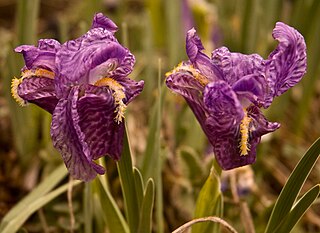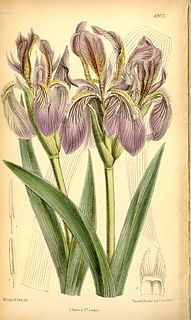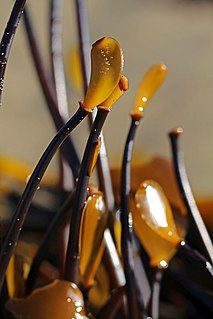
Anubias is a genus of aquatic and semi-aquatic flowering plants in the family Araceae, native to tropical central and western Africa. They primarily grow in rivers and streams, but can also be found in marshes. They are characterized by broad, thick, dark leaves that come in many different forms. The genus was revised in 1979 and since then its nomenclature has been stable. Species can be determined by using mostly characteristics of the inflorescence. Because of the often shady places where the plants grow, the genus was named after the Egyptian god Anubis, the god of the afterlife. The genus was first described in 1857 by Heinrich Wilhelm Schott, with A. afzelii as its type species.

Canna indica, commonly known as Indian shot, African arrowroot, edible canna, purple arrowroot, Sierra Leone arrowroot, is a plant species in the family Cannaceae. It is native to much of South America, Central America, the West Indies, and Mexico. It is also naturalized in the southeastern United States, and much of Europe, sub-Saharan Africa, Southeast Asia, and Oceania. Canna indica has been a minor food crop cultivated by indigenous peoples of the Americas for thousands of years.

Anubias barteri is a West African species of Anubias, first described in 1860 by Heinrich Wilhelm Schott. It occurs in south-eastern Nigeria, Cameroon and on Bioko.

Anubias barteri var. nana was first described by Adolf Engler in 1899 as A. nana. The species was reduced to varietal status in 1979.
Anubias gracilis is a plant that was first mentioned in 1920 by Chevalier and thereafter validly described by Hutchinson and Dalziel in 1936.

Bergenia crassifolia is a plant species in the genus Bergenia. Common names for the species include heart-leaved bergenia, heartleaf bergenia, leather bergenia, winter-blooming bergenia, elephant-ears, elephant's ears, Korean elephant-ear, badan, pigsqueak, Siberian tea, and Mongolian tea.

Anubias afzelii is a species belonging to the Aroid genus Anubias. It was first described scientifically by Heinrich Wilhelm Schott in 1857, based on material collected in Sierra Leone by Adam Afzelius, after whom the species was named. The genus Anubias was described simultaneously, with only A. afzellii belonging to it, which therefore is the type species of the genus. No other species currently placed in the genus Anubias was described earlier and A. afzelii was therefore the first species of this genus known to science.

Anubias heterophylla is a species belonging to the Aroid genus Anubias. It was first described scientifically by Adolf Engler in 1879.

Agrostis canina, commonly known as velvety bentgrass, brown bent or velvet bent, is a species of grass.
Anubias barteri var. angustifolia was first described by Adolf Engler in 1915 as A. lanceolata f. angustifolia. The species obtained varietal status within A. barteri in 1979.
Anubias barteri var. glabra is a variety of A. barteri that was first described by N. E. Brown in 1901.
Anubias gigantea is a species belonging to the Aroid genus Anubias. It was first mentioned by Auguste Chevalier in 1920, based on material that he had collected in Guinea. The formal description followed in 1939 by John Hutchinson. It is closely related to A. afzelii, basically only differing from that species by the form of the leaf-blade.
Anubias gilletii is a plant that was first described scientifically in 1901 by Émile Auguste Joseph De Wildeman and Th. Durand.
Iris heweri is a plant species in the genus Iris, it is also in the subgenus Iris and in the section Regelia. It is a rhizomatous perennial, from Afghanistan. It has tall, green curved leaves, tall slender stems and purple blue or violet-blue flowers, with white and purple or lilac beard. It is cultivated as an ornamental plant in temperate regions.

Iris hookeriana is a plant species in the genus Iris, it is also in the subgenus Iris and in the section Pseudoregelia. It is a rhizomatous perennial, from the Himalayan mountains of India and Pakistan. It has long pale green or yellow green leaves, long slender stem and fragrant blue, purple or lilac flowers, that are mottled with a darker colour. It is cultivated as an ornamental plant in temperate regions.

Iris kemaonensis, the Kumaon iris, is a plant species in the genus Iris, it is also in the subgenus Iris and in the section Pseudoregelia. It is a rhizomatous perennial, from Tibetan China, Bhutan, India, Kashmir and Nepal. It has light green or yellowish green leaves, that extend after flowering time. It has a short stem, 1–2 fragrant flowers that are purple, lilac, lilac-purple or pale purple. They also have darker coloured blotches or spots. It is cultivated as an ornamental plant in temperate regions. It is often known as Iris kumaonensis, due to a publishing error.

Iris scariosa is a plant species in the genus Iris, it is also in the subgenus Iris. It is a rhizomatous perennial, from the mountainsides of Russia, Kazakhstan, Mongolia and China. It has sword-like, or sickle shaped, blue green or grey-green leaves, a short flowering stem, 3 or 4 membranous or semi-transparent flower bud leaves, 2 violet, reddish violet, lilac, blue-purple, or blue flowers in late spring, with yellow or white beards. It is cultivated as an ornamental plant in temperate regions. It was merged with another similar iris in the region, and Iris glaucescens became a synonym of Iris scariosa, before being divided into two separate species again. Although some sources still call it the main species, despite a slight colour difference.
Anubias pynaertii is a species belonging to the Aroid genus Anubias. It was first described scientifically by Émile Auguste Joseph De Wildeman in 1910, based on material collected in Zaire by, among others, Léon Auguste Edouard Joseph Pynaert, after whom the species was named.

Anubias hastifolia is a species belonging to the Aroid genus Anubias. It was first mentioned by Adolf Engler in 1889 and described scientifically by him in 1893.

Laminaria sinclairii is a species of brown algae, in the family Laminariaceae. It is native to the lower intertidal zone of the northeastern Pacific Ocean from British Columbia southwards to California.













